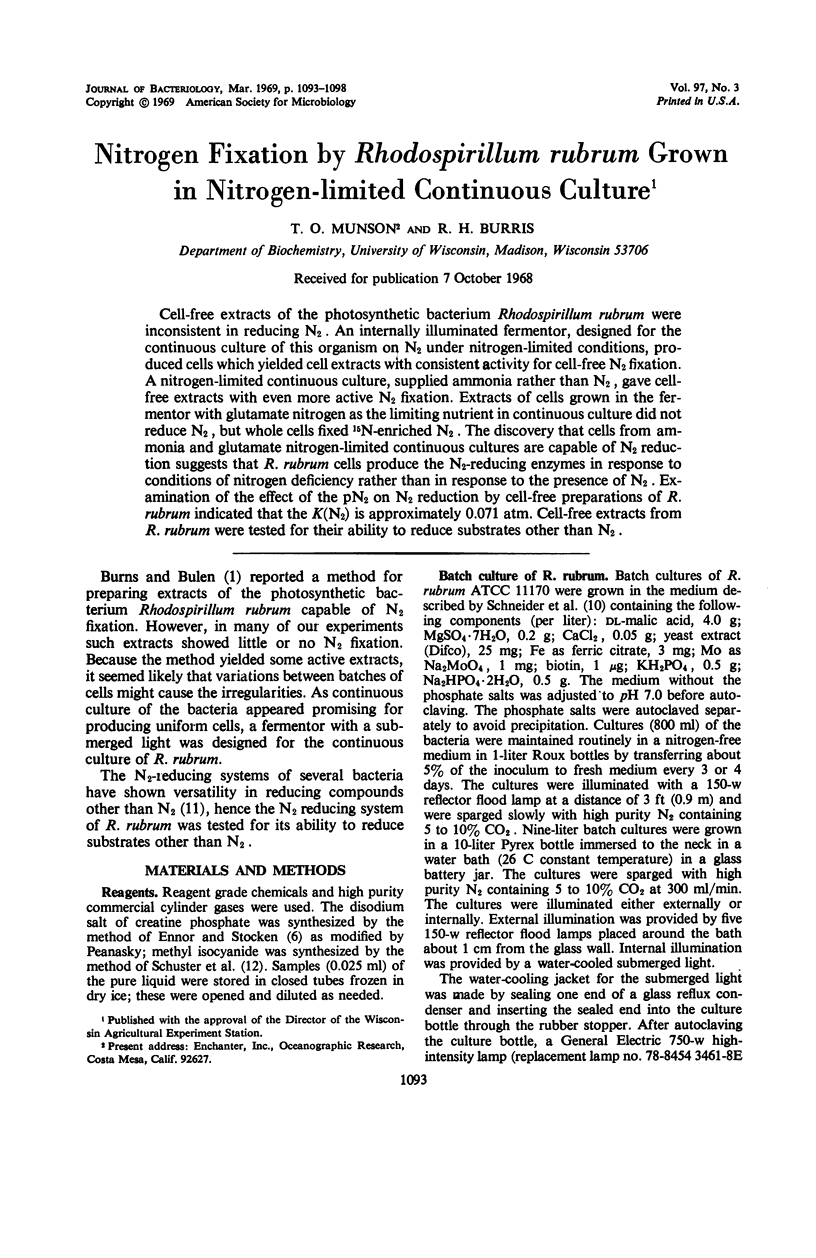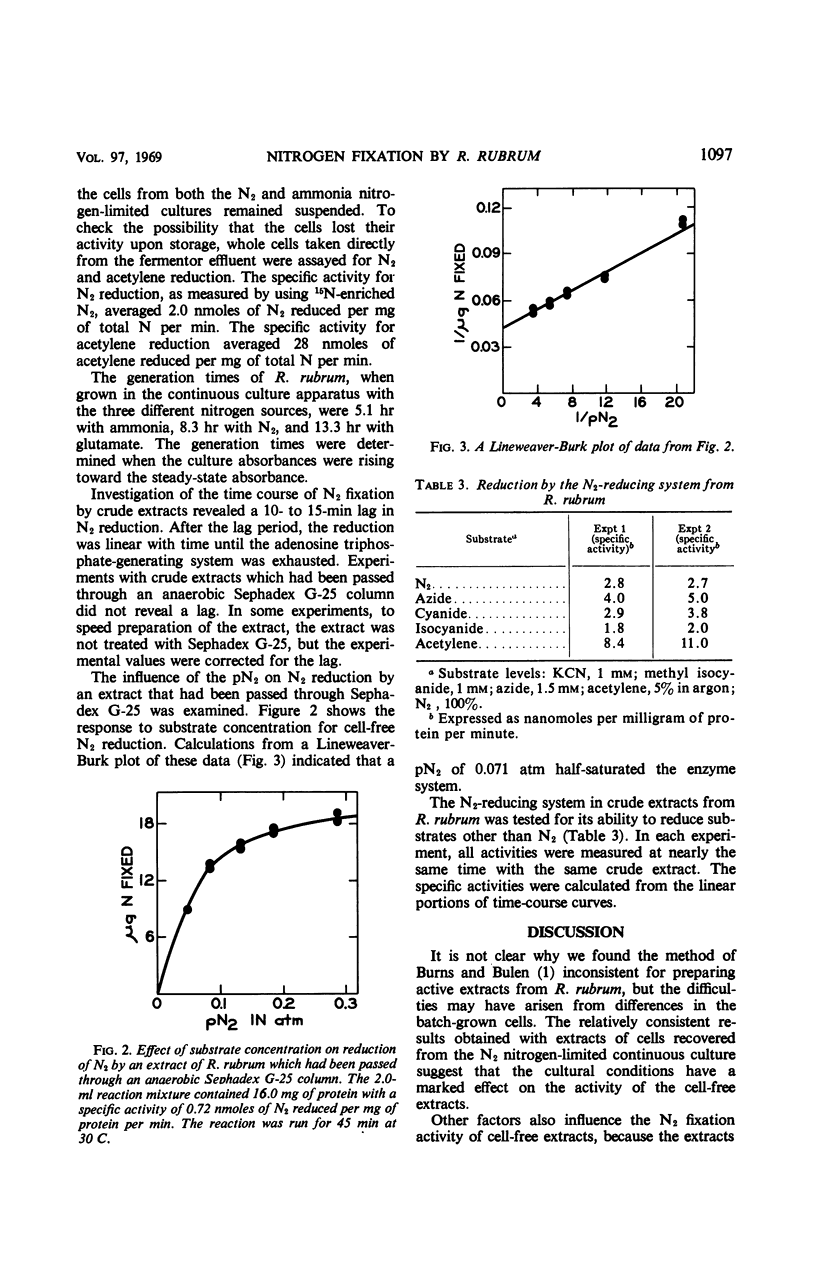Abstract
Cell-free extracts of the photosynthetic bacterium Rhodospirillum rubrum were inconsistent in reducing N2. An internally illuminated fermentor, designed for the continuous culture of this organism on N2 under nitrogen-limited conditions, produced cells which yielded cell extracts with consistent activity for cell-free N2 fixation. A nitrogen-limited continuous culture, supplied ammonia rather than N2, gave cell-free extracts with even more active N2 fixation. Extracts of cells grown in the fermentor with glutamate nitrogen as the limiting nutrient in continuous culture did not reduce N2, but whole cells fixed 15N-enriched N2. The discovery that cells from ammonia and glutamate nitrogen-limited continuous cultures are capable of N2 reduction suggests that R. rubrum cells produce the N2-reducing enzymes in response to conditions of nitrogen deficiency rather than in response to the presence of N2. Examination of the effect of the pN2 on N2 reduction by cell-free preparations of R. rubrum indicated that the K(N2) is approximately 0.071 atm. Cell-free extracts from R. rubrum were tested for their ability to reduce substrates other than N2.
Full text
PDF





Selected References
These references are in PubMed. This may not be the complete list of references from this article.
- Burns R. C., Bulen W. A. A procedure for the preparation of extracts from Rhodospirillum rubrum catalyzing N2 reduction and ATP-dependent H2 evolution. Arch Biochem Biophys. 1966 Feb;113(2):461–463. doi: 10.1016/0003-9861(66)90215-3. [DOI] [PubMed] [Google Scholar]
- Daesch G., Mortenson L. E. Sucrose catabolism in Clostridium pasteurianum and its relation to N2 fixation. J Bacteriol. 1968 Aug;96(2):346–351. doi: 10.1128/jb.96.2.346-351.1968. [DOI] [PMC free article] [PubMed] [Google Scholar]
- Dilworth M. J., Subramanian D., Munson T. O., Burris R. H. The adenosine triphosphate requirement for nitrogen fixation in cell-free extracts of Clostridium pasteurianum. Biochim Biophys Acta. 1965 Jun 22;99(3):486–503. doi: 10.1016/s0926-6593(65)80202-8. [DOI] [PubMed] [Google Scholar]
- Munson T. O., Dilworth M. J., Burris R. H. Method for demonstrating cofactor requirements for nitrogen fixation. Biochim Biophys Acta. 1965 Jun 15;104(1):278–281. doi: 10.1016/0304-4165(65)90245-x. [DOI] [PubMed] [Google Scholar]
- Schneider K. C., Bradbeer C., Singh R. N., Wang L. C., Wilson P. W., Burris R. H. NITROGEN FIXATION BY CELL-FREE PREPARATIONS FROM MICROORGANISMS. Proc Natl Acad Sci U S A. 1960 May;46(5):726–733. doi: 10.1073/pnas.46.5.726. [DOI] [PMC free article] [PubMed] [Google Scholar]
- Schöllhorn R., Burris R. H. Reduction of azide by the N2-fixing enzyme system. Proc Natl Acad Sci U S A. 1967 May;57(5):1317–1323. doi: 10.1073/pnas.57.5.1317. [DOI] [PMC free article] [PubMed] [Google Scholar]
- Stewart W. D., Fitzgerald G. P., Burris R. H. In situ studies on N2 fixation using the acetylene reduction technique. Proc Natl Acad Sci U S A. 1967 Nov;58(5):2071–2078. doi: 10.1073/pnas.58.5.2071. [DOI] [PMC free article] [PubMed] [Google Scholar]
- Strandberg G. W., Wilson P. W. Molecular H2 and the PN2 function of azotobacter. Proc Natl Acad Sci U S A. 1967 Oct;58(4):1404–1409. doi: 10.1073/pnas.58.4.1404. [DOI] [PMC free article] [PubMed] [Google Scholar]
- Wilson P. W., Hull J. F., Burris R. H. Competition between Free and Combined Nitrogen in Nutrition of Azotobacter. Proc Natl Acad Sci U S A. 1943 Sep;29(9):289–294. doi: 10.1073/pnas.29.9.289. [DOI] [PMC free article] [PubMed] [Google Scholar]


